
Using GOAL Deployment in support of their Strategic Plan, this company was able to align goals and objectives and achieve impressive organizational improvements
The Company historically used yearly Strategic Planning to lay out its macro goals and initiatives. This was done by each functional area of the company submitting what they believed they wanted to get accomplished during the following year. Unfortunately, since the process was done in isolation, many of the goals were misaligned and conflicted with each other.
Many organizations engage in this type of periodic strategic planning process where they identify and define key objectives. Gaps in actual business performance are identified and the organization is expected to determine how to close the gaps and achieve their goals. Unfortunately, a year goes by, and the organization fails to reach its goals.
The Company took the next step and identified potential initiatives to close the gaps. Often, they identified too many initiatives and as a result, little got successfully completed. While they did a satisfactory job of prioritizing the initiatives, they did not do an adequate job of communicating them throughout the organization. Management was left on their own to interpret what the initiatives meant and how to close the gaps. As a result, they lost alignment with the strategic goals.
The CEO decided it was time to revise the strategic planning process, so he introduced the concept of policy deployment
The CEO was concerned that the phrase policy deployment sounded too bureaucratic and esoteric. It was suggested the company use the phrase GOAL Deployment where GOAL stood for Greater Organizational ALignment. Policy Deployment is also referred to as Hoshin Kanri. He used the graphic below to illustrate the concept of GOAL Deployment:
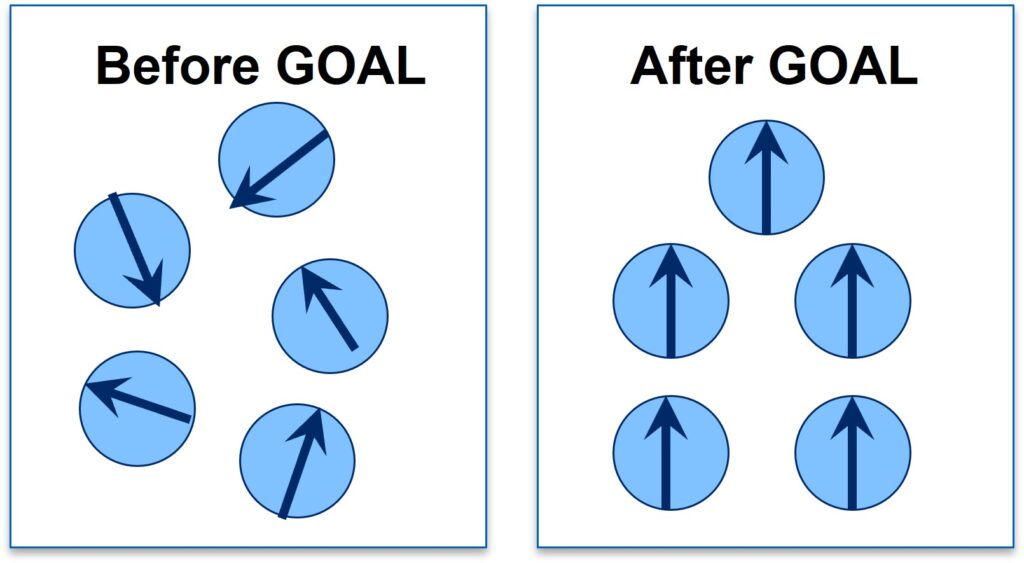
He assigned the training and execution support to the company’s Continuous Improvement group and their Master Black Belts (MBB). GOAL Deployment was integrated into the company’s deployment of Lean Six Sigma. The following graphic shows this integration.
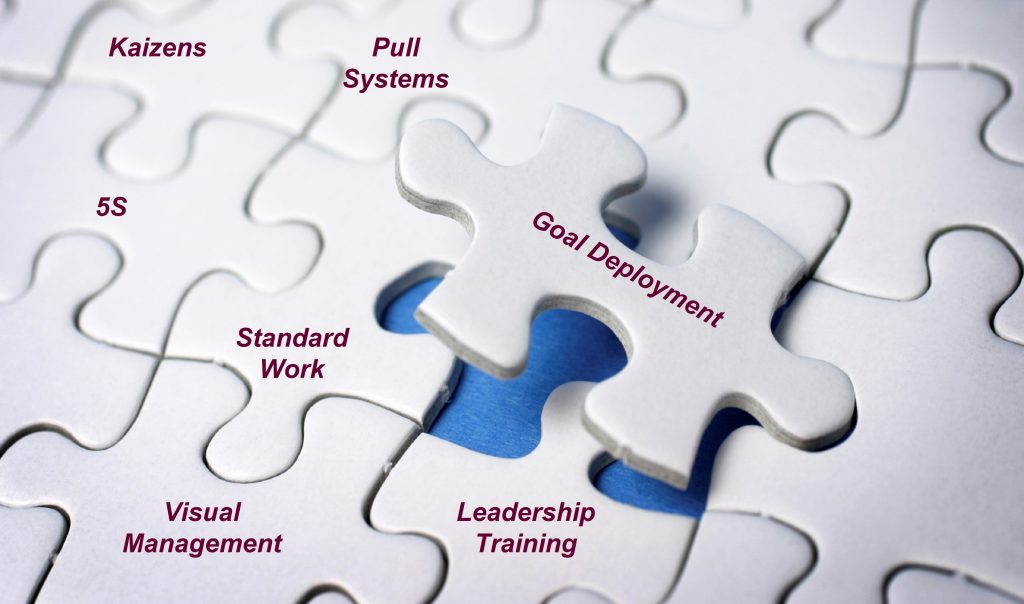
The GOAL Deployment process can be described in the following steps:
- Establish a common direction agreed upon by senior management – the company’s true north where everyone is aligned on the direction of the company. This will require breakthrough thinking.
- Identify the gaps in current performance. Typically, you will restrict this to just 3 to 6 gaps.
- Identify the strategic initiatives that will close the gaps. Ideally, there are no more than five of these each year. These will be significant initiatives by the organization.
- An implementation plan is developed for each initiative. This is at a high level. Accountability and responsibility for each initiative are identified, as well as expected completion dates, and key milestones.
- The means to assess the effectiveness of the initiatives to close the gaps are determined along with key metrics and measures. Typically these measures cover the categories of Safety, Quality, Delivery, Productivity and Growth (SQDPG). There should only be four to six measures in total.
- Summarize all this information in a single page document that can be easily communicated throughout the organization.
The steps of GOAL Deployment can be captured with the following graphic:
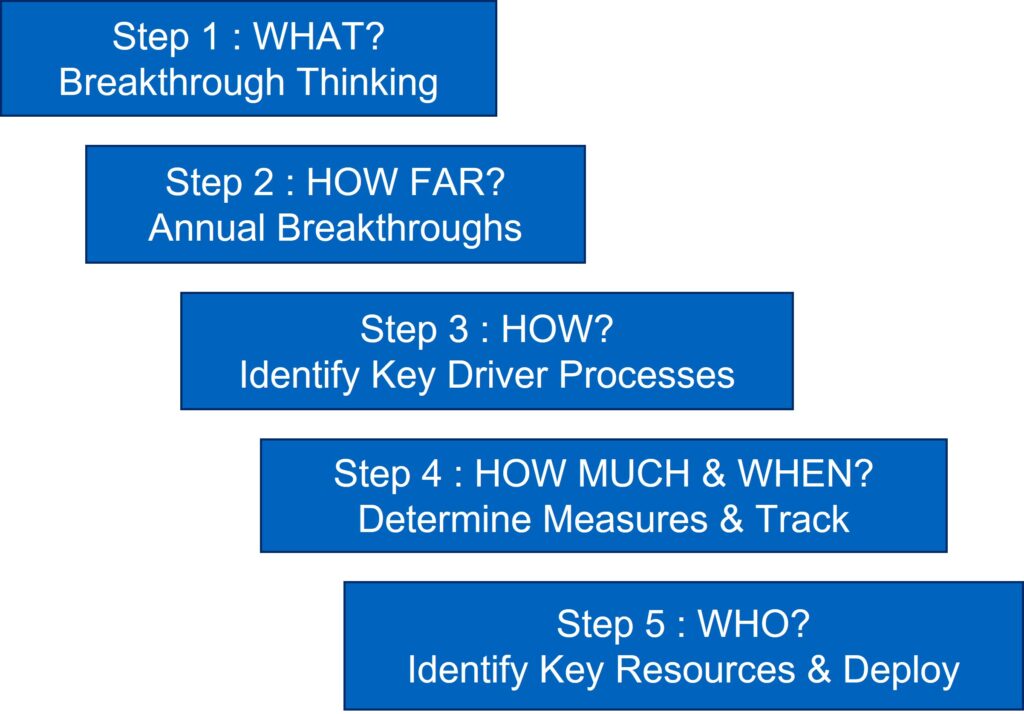
Here is a little more detail for each of the steps:
Step 1 – What is breakthrough thinking?
- Represents significant change and breakthrough improvement in your processes, especially as seen through the eyes of the customer
- Requires the organization to stretch itself
- Usually requires multi-functional efforts and teamwork
- Usually, no standard or system exists for this level of breakthrough (you have to create it)
- Can be characterized as a Big Win
Step 2 – Develop annual breakthrough objectives
- Start with identifying 3-5 year breakthrough objectives
- Obtain fact-based understanding of your current situation
- Identify how far to improve in the first year in order to hit the 3-5 year breakthrough objectives
- Quantify the gap between the current state and your annual breakthrough objective
Step 3 – Identify key driver processes
- Use appropriate root cause analysis tools
- Use problem solving tools to find ways to bridge your gap
- Find the key driver process with the greatest influence and identify your improvement priorities
Step 4 – Determine key measures and track them
- Targets are measures of the effectiveness of a given process
- Think statistics and process capability
- Improvement priorities tell you how, while targets tell you how much and by when
Step 5 – Identify key resources and deploy them
- Identify the resources with the greatest influence or opportunity to impact the improvement priority and target to improve
- The largest or most available resources will not always have the greatest impact
Senior management was trained first and the process cascaded to subsequent levels of the organization
The training kicked off with the senior MBBs training the executive leadership of the company. They helped them identify the critical elements of GOAL Deployment and to construct the highest-level GOAL Matrix. Shown below, it is the one-page format which captures the five steps of GOAL.
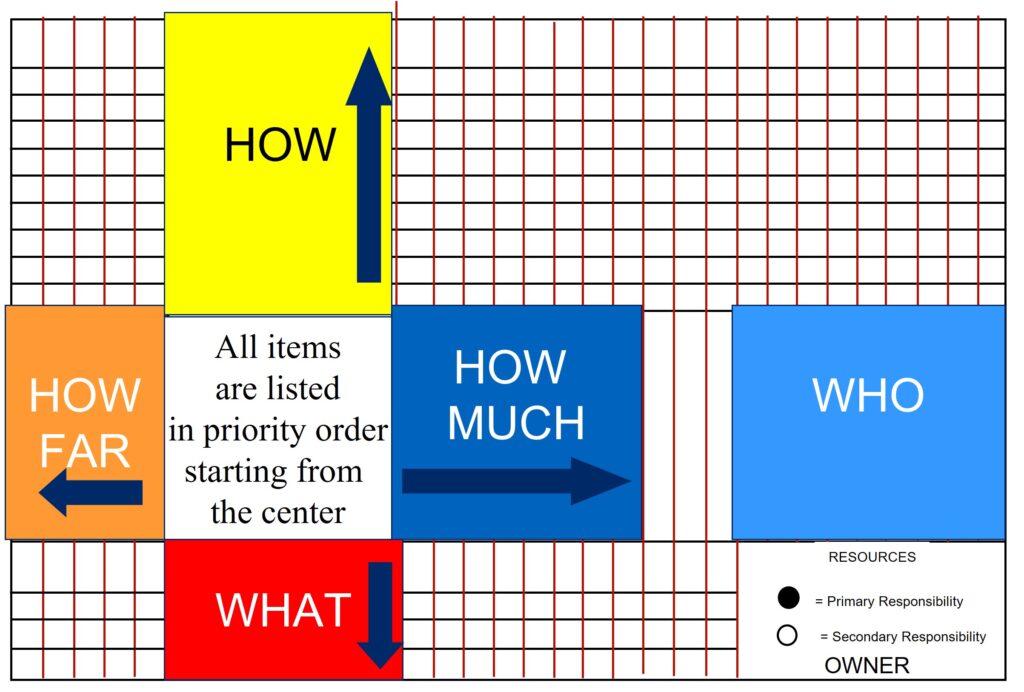
Here is the matrix with a little more detail:
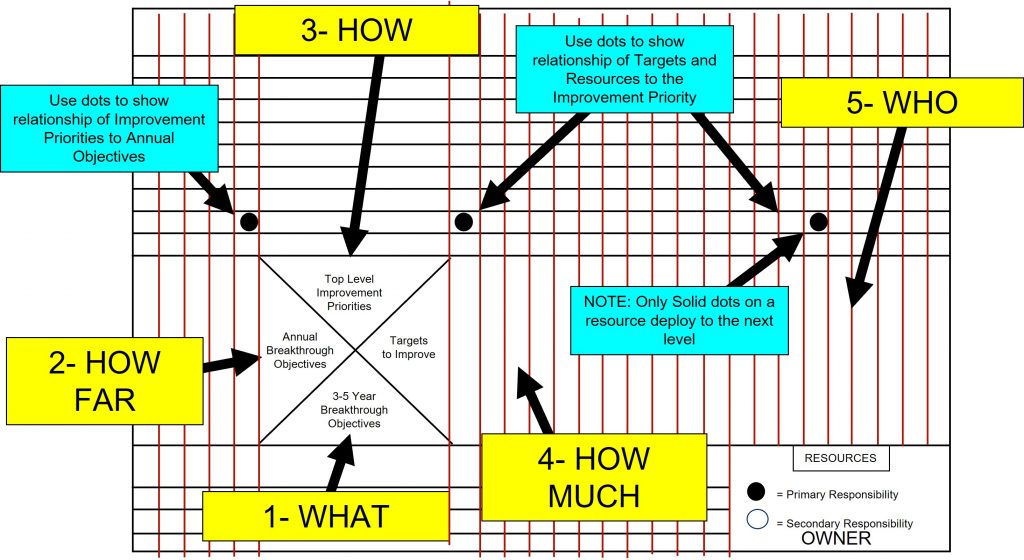
Once the senior leadership completed their GOAL Matrix, the next level of training was conducted using the top-level GOAL Matrix as a format for the creation of the next level GOAL Matrix. This process continued to cascade down the appropriate levels of management with the relevant manager doing team teaching with MBBs for their functional organization.
A completed first level GOAL Matrix would look like this:
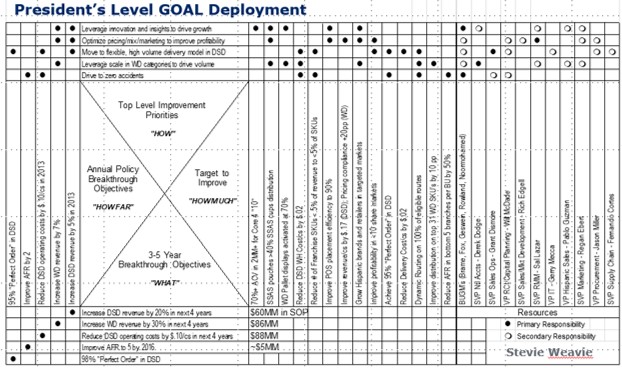
Lower-level GOAL matrices will flow from the high level one.
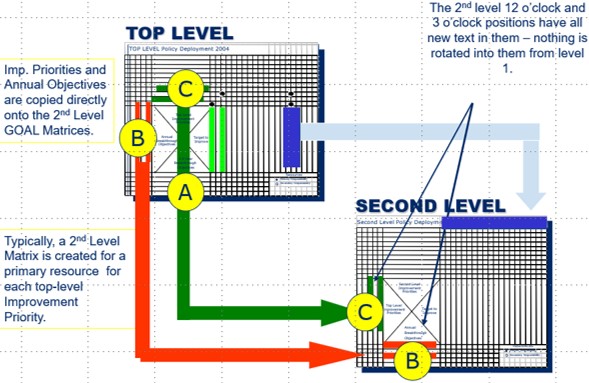
Eventually, the cascading GOAL matrices need to end with an action plan for improvement and achievement of the goals
The number of times the matrix cascades depends on the size and complexity of your organization. This company cascaded down to the functional manager level. That is where the root causes could best be identified and problem solving, and process improvement could occur.
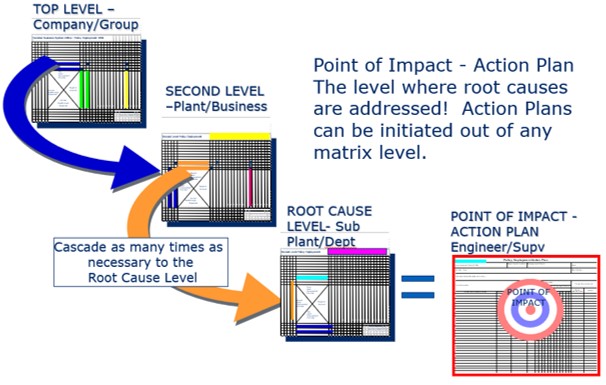
The final step in the process is to start tracking the metrics and then take action to close the gaps
Simple colored bowling charts were developed for the critical measures in the GOAL Matrix. See an example below:
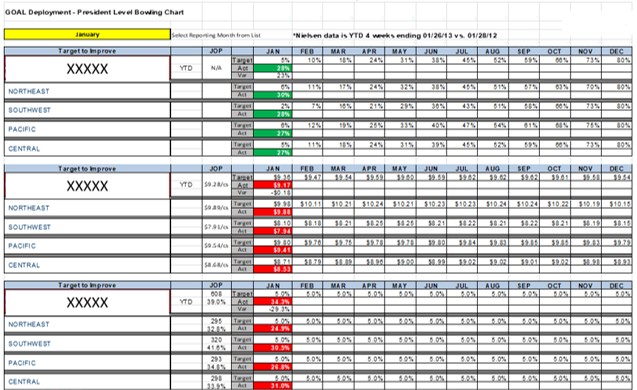
The basic improvement approach that the company took was the use of the PDCA Cycle. Other tools such as Kaizen events and DMAIC were also used.
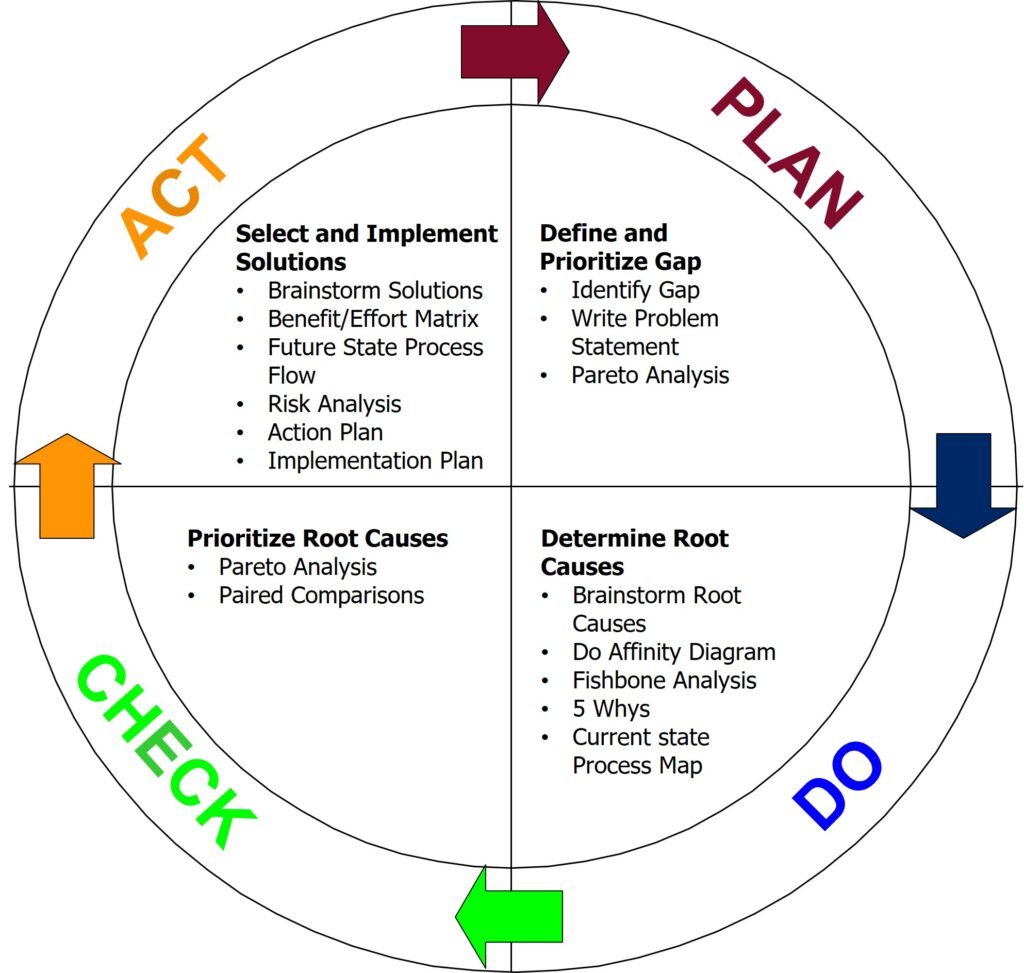
The alignment of goals and actions resulted in positive changes for the company
The purpose of GOAL Deployment is to:
- allow everyone in the company to be aware of senior leadership’s vision
- prevent departments and functions from destructively competing
- facilitate improvement projects to successful completion
- Improve the company’s quality and profitability by having everyone aligned with the strategic objectives
After the strategic plan is deployed, goals are aligned, action plans are developed, and gaps are closed, it is critical that leadership stay engaged as to what is happening and to adjust as needed. New opportunities or threats may arise requiring additional goals or new action plans. Sometimes you will have to adjust timelines as unexpected situations arise. The GOAL Deployment Matrix, bowling charts and action plans are not one-off activities.
GOAL Deployment is one of the most critical things executive leadership does. It is how the organization determines where it wants to go and provides the map and tools to get there.